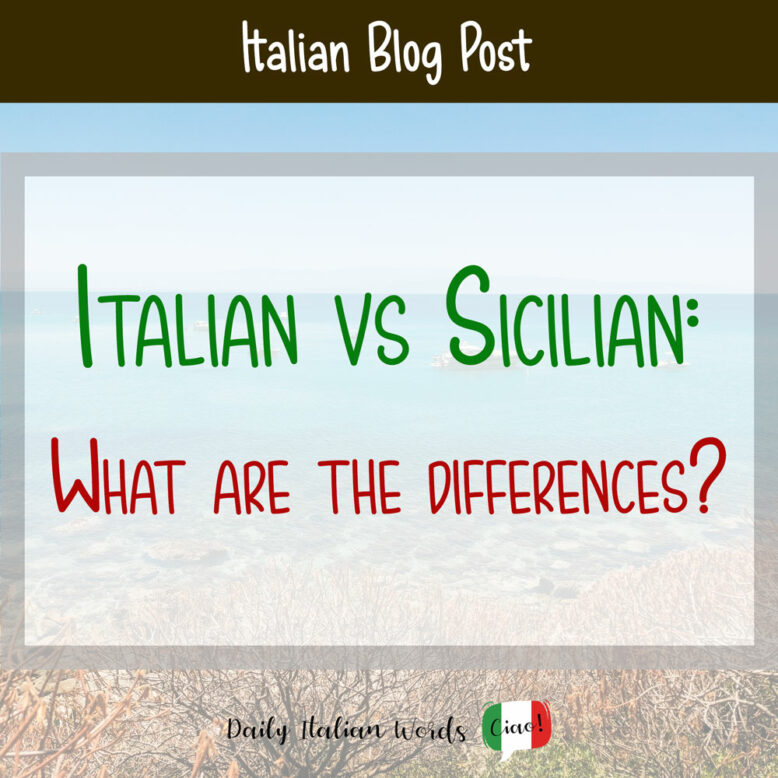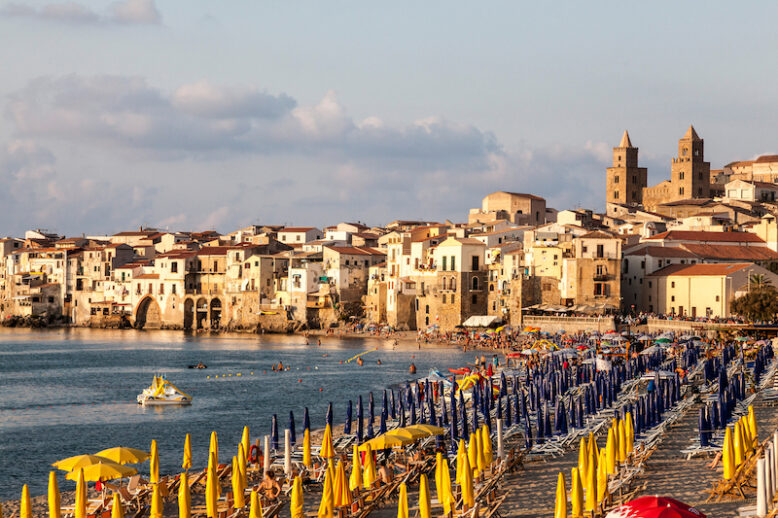Sicilian, which in Sicily is known as sicilianu, is a Romance language like all the dialects distributed across the Italian Peninsula. With more than five million native speakers, mainly located in Sicily, this dialect descends from a variety of historical languages.
This is owing to the geographical position of the island, located strategically in the middle of the Mediterranean Sea, which the Romans dubbed Mare nostrum: a sea totally surrounded by Roman possessions.

Sicilian language history
First of all, it is important to state that Sicilian boasts the oldest literary tradition of all the modern Italian languages. And even though today this language is not officially recognised, it remains the common tongue that native speakers use daily to talk with friends and family in various areas of South Italy.
In his analysis of 5000 terms in the Dizionario etimologico siciliano, Salvatore Giarrizzo discovered that more than 50 percent of the lexicon derives from Latin. According to his research, the strong influence was the result of invasions brought about by the Greeks, Spanish, and Moorish.
Sicilian is, of course, rooted in a remote past, and its language began its complex journey through international contact. Phoenicians and Carthaginians had the greatest influence before the Romans conquered Sicily in the 3rd century B.C., bringing with them the Latin language to the island.
In this historical phase, Sicily was inhabited by those who were thought to be the indigenous Sicanians. But Sicels and Elymians too reached this land during the first and second millennia B.C. They were one of the larger prehistoric groups living on this Mediterranean island at the time.
The first indigenous people then entered into contact with Greeks, Phoenicians, and Moors, who went on to mould and enrich the already well-established Sicilian lexicon.

Sicilian ethnolinguistic stratification
Sicilian is an interregional language with a variety of dialects spread across the main island, the Sicilian archipelagos, South Apulia, Reggio Calabria, and South Campania. These are the main linguistic variants:
- Southern Salerno, Campania: Cilentano dialect
- South Apulia: Siculus or Sìculo, Salentino dialect
- Reggio Calabria: Reggino
- Palermitano: Palermo and the vicinity
- Trapanese: Trapani and the vicinity
- Agrigentino: Agrigento and the vicinity
- Ragusa and Syracuse
- Ennese: Enna
- Catanese: Catania province
- Messinese: Messina
- Eoliano: Aeolian Islands
- Pantesco: Island of Pantelleria
The distinctions do not end here. Indeed, Sicily during the last few centuries has been struck by a widespread phenomenon: emigration. The migratory flow was mainly directed to specific destinations such as the USA, Canada, Australia, Argentina and Venezuela.
Considering that Sicilian was the first language, and sometimes even the only one spoken by these emigrants, once abroad they would mix their mother tongue with the local ones to create a brand new variant.
One of the new linguistic variants that originated from this event was Siculish – that is, Sicilian and English merged into one. Depending on the English variant, it was called either Siculo-American or Siculo-Australian.
Did you know that…
The phrase U ziu d’America (“the uncle from America”) is an old-fashioned Sicilian nickname for a relative who immigrated to the USA?
Despite having reached many countries, Sicilian is sadly categorised as an endangered language. UNESCO listed it as a dialect at risk of extinction along with around 30 Italian dialects that are becoming less and less used in Italy, such as Neapolitan. The main culprit is the widespread usage of standard Italian, preferred not only in schools and the media, but also official and public documents.

Sicilian Vocabulary
The differences between Italian and Sicilian are so plentiful that it is difficult even for linguists to figure out exactly where the latter comes from. Indeed, the origin of Sicilian is still highly debated, and real evidence of its older past is not yet completely retraceable.
Words in particular have roots and endings that are quite different. Let’s see an example.
Mi chiamo in Italian (which means “my name is”) becomes mi mìsiru (name) in Sicilian. Likewise, the Sicilian for bon appetit is bona manciata, which in Italian is closer to the French version: buon appetito.
Sicilian and Italian words – a comparison:
- Please: Pi fauri, per favore (Italian)
- Say that again: Mu dicissi arreri, me lo puoi ripetere (Italian)
- Maybe: Forsi or Capaci ca or Sap’iddu, forse (Italian)
- I understand: Lu Capisciu, capisco (Italian)
In some cases, the Latin root is clear, but not always.

Phonetic changes
Although Sicilian and Italian use the same alphabet, the pronunciation varies, and not all dialects of Sicilian share the same features. That said, it is common to see the following changes:
- b generally becomes v;
- Double l turns into a double d;
- g at the beginning of a term or in between vowels is silent or lightly pronounced;
- Italian words with a single consonant can be pronounced as if they were double;
For instance, the word broccoli becomes vròcculu. And to throw away, gettare, loses its g in favour of a lighter sound: gittari.
Double consonants are among the most used in Sicilian, and they intensify and strengthen the pronunciation of standard Italian words. For example, horse in Italian is cavallo, while in Sicilian it changes into cavaddu. The same phenomenon can be observed with bello (meaning ‘nice’), which in the Southern dialect turns into beddu.
Similarly, final vowels tend to become i or u. More precisely, the vowel becomes i when the Italian term ends in e, whereas it changes to u when the Italian word ends in o. This is evident in words such as botte (barrel) which becomes vutti in Sicilian, as well as in gatto (cat) which becomes attù. In this last example, we can see once again how the g is softened to the point that it is hardly pronounced at all.

Conclusion
In summary, Sicilian and Italian, despite having much in common, are two unique languages with more than a single difference separating them. Although local authorities have pushed schools to teach Sicilian in their classes, its future as a living language looks somewhat grim. Will Sicilian lose ground to standard Italian and leave behind nothing but ancient documents of the mighty language it once was? Only time will tell.
About the author: Fabio Guarino
As a Linguist and Language Specialist, working as a Freelance Content Writer and SEO Marketer allows me to combine my passions and interests with my career. My favourite thing about working with languages is playing with words. And this is something I’ve always dreamed about since I started to wander the globe and study languages.
The audio files were kindly provided by Dario Scimone. You can follow him on Instagram where he shares his images of Sicily.

Fabio Guarino is a Linguist and Language Specialist who operates as a Freelance Content Writer and SEO Marketer. He considers himself fortunate to be able to blend his passion for his native language, Italian, along with English and Spanish, with his career.


